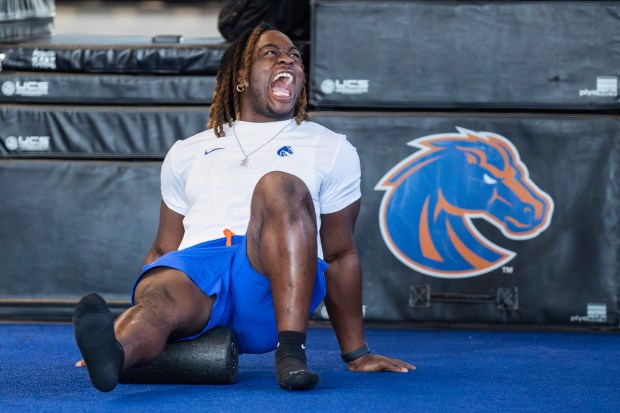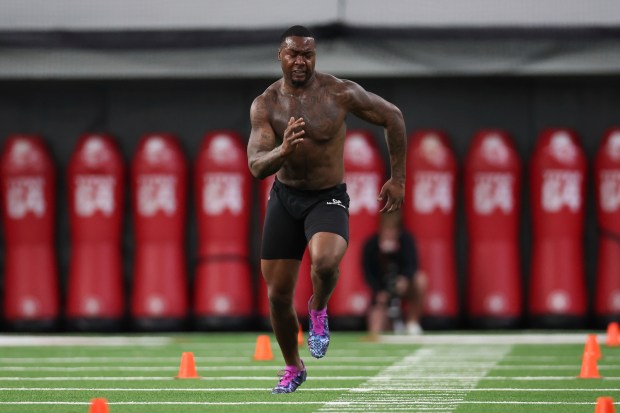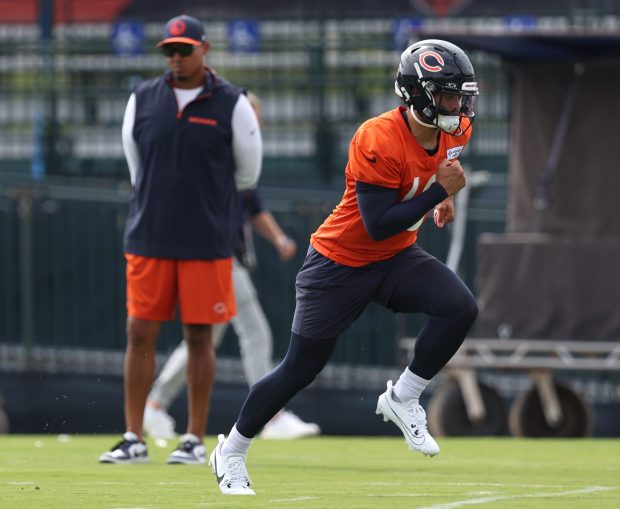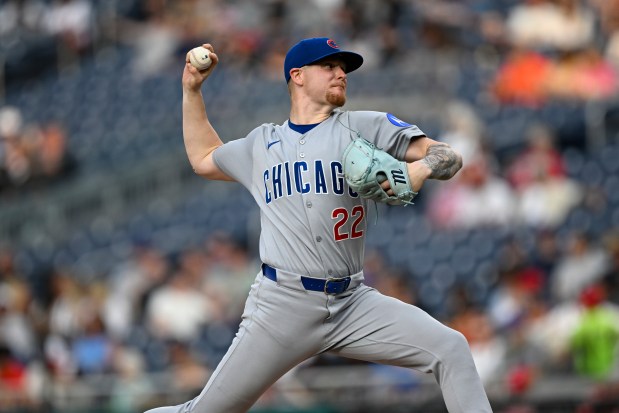April is here, and the NFL draft is a mere three weeks away. The Chicago Bears brass — including general manager Ryan Poles and coach Ben Johnson — have returned from the owners meetings in Florida to delve into the final stretch of draft preparations.
The Tribune’s Brad Biggs tackles plenty of 2025 draft questions in this week’s Bears mailbag — but he begins with an inquiry about one of last year’s top picks.
With all of the moves the Bears have made, from the coaching staff to upgrading the interior of both lines, not much has been said about Rome Odunze’s rookie season. This is a top-10 pick in last year’s draft. In spite of the offense being a total mess, how do you think he performed and do you expect him to become WR1 before his rookie contract expires? — Corey S.
That’s a good question, and the short answer is, as the No. 9 pick and the third receiver selected in a deep draft at the position, he better be. There’s no question that was the team’s projection when it made the selection.
Odunze finished last season with 54 receptions for 734 yards (a 13.6 average) and three touchdowns. I thought he got better as the season went along, even though you didn’t necessarily see a steady uptick in production. His opportunities were inconsistent; he had four targets or fewer in five games, including the final two. With Keenan Allen out of the picture, you can expect the ball to come Odunze’s way more regularly.
The reason I say Odunze showed improvement is he began to show the ability to uncover and make himself available. He improved as a route runner as the year unfolded and he learned some of the subtle nuances required when you’re not necessarily physically superior to the cornerback on every snap, as is often the case for elite wide receivers in college. He has the traits to be successful in the NFL: a big body (6-foot-3, 215 pounds), a large catch radius and the ability to turn 50-50 balls into 70-30 propositions for quarterback Caleb Williams.
The key for Odunze to blossom into an eventual No. 1 receiver is his ability to get open. That’s what separates the top tier of receivers from the rest of the league. He has to be able to win at the line of scrimmage and coming out of his breaks, and that’s a product of improving his route running and learning how to use his size and length.
You don’t want to be in a situation where your No. 1 receiver needs to be schemed open, and that happens with a lot of rookies where they need play action to create a void or space for catch-and-run opportunities. Sooner or later — preferably sooner — Odunze needs to be able to consistently defeat man coverage. He already has shown the ability to do this, but to be an elite No. 1, it needs to come more regularly. If that happens, I think you’ll wind up pleased with his developmental arc.
In a perfect world, the Bears would be drafting a player to be a No. 2 behind Odunze in three years or so.
How do you rank Ryan Poles based on the last three years of drafting? I feel like if it wasn’t for the Panthers trade, Poles has not done anything impressive. Caleb Williams, Ben Johnson and all the O-line additions are yet to be proven. — Dhana M., Peoria
I don’t want to cop out on an answer, but most folks in the league will tell you it takes three years to evaluate a draft class. Can you see clearly great picks before three years have elapsed? No doubt. Can you identify players who fizzled out in less time? You can, and teams will cut bait quickly in some cases.
Poles’ first draft class in 2022 had 10 picks, but seven were in the fifth round or later. Nickel cornerback Kyler Gordon looks like a mainstay for the future. Strong safety Jaquan Brisker has been solid at times and is entering the final year of his rookie contract with durability concerns. To get a starting left tackle in the fifth round like Braxton Jones is a hit.
The Bears need right tackle Darnell Wright to elevate his game as the No. 10 pick in 2023. If defensive tackle Gervon Dexter can break out in Year 3 and cornerback Tyrique Stevenson becomes more consistent, this could be a solid class.
Last year’s draft is all about the ascension of Williams and how wide receiver Rome Odunze performs. If Williams becomes a top-tier quarterback, Poles’ first three years will have gone pretty well. You don’t need me to tell you the position has been the organization’s missing link for decades.
The key to drafting moving forward — with Johnson on staff now — will be finding fits that can be developed within the system. That sounds easier than it is because that’s every organization’s goal. It doesn’t mean handing over the keys for the draft to the coaches because they don’t spend all of their time evaluating prospects. It’s about developing synergy between the scouting and coaching staffs.
There’s a chance for Poles’ first three drafts to look pretty solid if some players make gains, but much of this is about Williams, the No. 1 pick a year ago, and where his career heads. As far as the other stuff — you alluded to the trade with Carolina — that’s a separate evaluation. Let’s see what the draft brings at the end of this month.
What impact would Ashton Jeanty have on opposing defenses? Would they shy away from having eight men in the box? Would they blitz less often? I would appreciate your thoughts on the intangibles Jeanty brings. — Tom C., Park Ridge
The impact Jeanty would have on defenses is pretty obvious. He has a tremendous combination of contact balance, power and speed. He runs with great vision and patience, has the ability to spin off and push through the first tackler and is gifted in the open field. He would stress the defense as an elite runner, and that’s why he’s the rare running back being considered as a top-10 pick, a topic I took a close look at last week after chatting with a variety of folks.
NFL defenses aren’t putting eight players in the box a whole lot anymore because offenses are spreading them out. The number of defenders in the box depends more on the personnel grouping — the number of running backs and tight ends on the field versus wide receivers — than the quality of the running back. If an offense comes out in 12 personnel (one running back, two tight ends and two wide receivers) and the tight ends are attached to the formation, there’s a chance eight defenders would be in the box. I’m not sure Jeanty’s presence would affect the number and variety of blitzes the offense would face either.
As far as intangibles, everyone I chatted with gave Jeanty high marks, including former Tampa Bay Buccaneers coach Dirk Koetter, who was the offensive coordinator at Boise State last season. He projects Jeanty as a team leader when it becomes his turn.
How does a GM quantify the difference between an elite talent such as Ashton Jeanty and good options like Omarion Hampton, TreVeyon Henderson and Quinshon Judkins? Assuming a back taken in the first two rounds has to run, catch and block, how much more valuable is breakaway speed than hard running? Does a GM project total yards potential? Situational advantages? Skill sets of backs already on the roster? What about gate appeal? The Bears seem to sell out all their home games, but how much more revenue could Jeanty bring in than one of those other backs? — David S.

Wow. There’s a lot of ground to cover here. Assuming all of the running back options you listed are available, you’re talking about a multifaceted discussion. First, you’re stacking a board of running backs and determining the order in which you prefer them based on their skill sets and how you see them performing in all areas of your offense. How durable do you believe they would be? Are you confident in their ability to learn? How do they rate as a teammate and self-starter?
I’d agree that if you’re drafting a back in the first two rounds, especially where the Bears are selecting in Round 2 at Nos. 39 and 41, you’re expecting him to contribute on all three downs. A discussion between top-end speed and hard running is a matter of preference, right? What are you emphasizing? A physical back who can set the tone or a player who can go the distance? In a perfect world, you get both, and some believe Jeanty is the elite prospect who checks all of those boxes.
Obviously you’re going to consider the skills of players you have on the roster and try to have the best combination, but ultimately the goal should be to get the best players in the draft, period. Gate appeal? You lost me here. The best gate appeal for the Bears — and one they’ve mostly been missing — is winning football. That’s what sells.
If Jeanty is available at No. 10 — a big if — the Bears would have to weigh his ability versus that of players at other positions on the board. They can wait until Round 2 and get a really good running back. They might be able to get a good one in Round 3. They need to determine if Jeanty is special enough to warrant the 10th selection and wait until Round 2 to look at other positions, including both lines, linebacker, cornerback and maybe even safety. Tight end probably will be in the mix too.
Am I the only one to think that all the fuss about Will Campbell’s arms being an inch too short to play tackle in the NFL is much ado about nothing? The man can ball. — Barry, Oak Lawn
I agree the LSU product is a heck of a player, and I expect him to have a very good NFL career. Where he winds up playing, we’ll have to see. The arm-length discussion is fair with Campbell, who measured 32 5/8 inches at the scouting combine — roughly 1½ inches shorter than ideal. The first thing teams go on is the game tape, and his is pretty good.
Here’s what a veteran scout told me when I asked him about Campbell last week:
“Really interesting one. I was in Baton Rouge (La.) about midseason and I was like, ‘Holy smokes, this kid is the real deal.’ I know he’s got short arms, but at that point in the season, I hadn’t seen where it really affected him. I put a big grade on him.
“I was watching cross tape and a couple of games late in the season where his lack of length showed up. I kept a big grade on him, but my confidence was lowered a little bit. Campbell is super athletic. He’s got good strength. He’s super smart and I think he will be able to figure out how to play the position and overcome his deficiencies, which is length, but he did have some hiccups there late in the season.
“I think he would be an unbelievable guard if someone has the (guts) to play him there, but if you’re drafting him and you don’t have an established left tackle, you’re probably starting him there first and you see how he handles it.”
NFL mock draft 1.0: Who will the Chicago Bears select with the No. 10 pick?
Joe Thuney has not been extended and is still on a one-year deal. Is it at all possible that the Bears will retain him for the year, groom someone younger behind him and try to use the compensation system to recoup their draft pick in 2027? — Tom S.
I suppose your scenario is possible, but I seriously doubt the Bears acquired Thuney with a plan to play him for only one season. Then what? Back to the drawing board for a starting spot on the line — assuming the other four starters play at the desired level and remain healthy? That doesn’t seem like a great plan to me, especially if the Bears wind up with Braxton Jones or Kiran Amegadjie at left tackle with the knowledge they’d have to reevaluate that position in 2026 if neither one takes a significant step forward. Now you’re talking about having to replace the left side of the line next March. We’ve seen that movie before, haven’t we?
If the Bears thought Thuney had only one season of high-level play remaining, they probably wouldn’t have made the move for him. In the event they are considering this as an option, you should know the highest compensatory draft pick they could receive for Thuney would be a fifth-round pick in 2027. The league caps comp picks at Round 5 for players with 10 or more years of service, and this will be Thuney’s 10th season.
My hunch is the Bears will look into a possible extension for Thuney. The fact one hasn’t been completed yet is neither surprising nor concerning. The front office has been busy with free agency and draft preparation. It takes two to get a deal done, so obviously Thuney would have to want to sign an extension.
Do you know if the Bears have any 2025 plans for Ian Wheeler? I know it was preseason, but he did show a little something before the knee injury. — Craig B.
There were a couple of questions about Wheeler in the last two weeks. “Hard Knocks” did a nice job of introducing the undrafted rookie from Howard to fans last summer. Provided he has a smooth return from a torn ACL, he will have a chance to compete for a spot at the back end of the roster. Given his size and lack of experience on special teams, he’s probably a long shot to make the 53-man roster.
Obviously if the Bears spend a high draft pick on a running back, it will be more difficult for Wheeler. But there’s no way of telling until we see him on the field in the summer. I can tell you Ryan Poles really liked Wheeler, and when I saw him around the building during the second half of last season, he was always upbeat and grateful for the opportunity ahead.
If Roschon Johnson is healthy, does he factor in the new offense? All the backs will look better with a much-improved O-line, I would think. — Eric H., Houston
There was also a handful of questions about Johnson this week, and like I said above, any additions at running back via the draft would affect players lower on the depth chart. So speculation right now is sort of moot.
The clearest path to a roster spot for Johnson will be making himself indispensable on special teams. He played 132 snaps on special teams last season and 152 as a rookie, so he’s gotten some work in that phase. He’ll need to step up and show he can do more.
On offense, he’ll probably begin as the third option in the backfield — assuming the Bears get a back in the draft they like — and there aren’t a lot of snaps or carries for No. 3 running backs, provided everyone remains healthy.
Is there a decent edge rusher the Bears can get at No. 10? — @popa_pep

That’s a good question. I’m not sure there is an edge defender who looks like a slam dunk at that pick; Penn State’s Abdul Carter will be long gone before then. Georgia’s Mykel Williams is probably the best option, and he is intriguing and worth a close look. He’s 6-foot-5, 260 pounds and has great length with 34 3/8-inch arms. He profiles as one of those bigger, longer, explosive defensive ends who have had success playing under defensive coordinator Dennis Allen. His production at Georgia wasn’t always consistent, but he doesn’t turn 21 until June and his ceiling is considerable.
For me, there are too many questions about Shermar Stewart’s lack of production at Texas A&M, but he’s the most physically gifted athlete in the draft at this position — maybe any position. Georgia’s Jalon Walker is interesting, and some teams might eye making him a full-time defensive end. He could be an outside linebacker in a 3-4 scheme because he has the ability to play in space. He doesn’t have the size at 6-1, 243 that Allen typically has had in edge rushers.
I think No. 10 is too high for Marshall’s Mike Green. He has been accused of sexual assault twice and publicly denied both incidents. That’s something teams will want to dig deep on before considering him.
Why haven’t we heard much about Deone Walker, the defensive tackle from Kentucky? The writeups sound like he would be perfect for the Bears D-line. Negative tape? Something else? — George T., Savannah, Ga.
Walker got a lot of buzz last summer after a terrific 2023 season for Kentucky. The short answer is he wasn’t nearly as impressive on tape last year. That’s what I was told by scouts who watched the Wildcats. Walker is massive at 6-7, 331 with 34-inch arms, and a twitched-up version of him would be a perfect fit in the middle of just about any defensive line. The thing is, Walker wasn’t great last season and might not have been in the best shape. Subsequently, his production dipped.
The Bears have that big guy for the line on the roster in Gervon Dexter, and they have a nose tackle in Andrew Billings. Finding a tackle with a disruptive ability to get after the quarterback makes sense. Walker would have to be a lot more consistent in the NFL and play with better leverage to be a high-end player.
What do you think Kiran Amegadjie and Tyrique Stevenson’s standing is with the new coaching staff and how do you think that affects the draft plans? — @acs624
If the new coaches are doing this the right way — and we’ve heard Ben Johnson talk about it being a fresh start for everyone — they aren’t looking at either player with preconceived notions. Amegadjie appears to have an opportunity to compete for the starting left tackle job, especially if he gets a bit of a head start while Braxton Jones rehabilitates from ankle surgery. My hunch is Stevenson will be the first man up as the starting cornerback opposite Jaylon Johnson with an expectation he needs to perform to win the job.
That being said, neither player is so established that it would prevent Ryan Poles from drafting a player at either position in Round 1 and immediately changing the depth chart. The Bears probably don’t have as many of those guys — players who couldn’t be replaced by a first-round pick — as you imagine.
How far do you think the Bears would be willing to trade back? — Matt B., St. Joseph, Mo.
The Bears need more impact players on their roster. They’ve probably added two this offseason in center Drew Dalman and left guard Joe Thuney, with a chance for others to be close to that if they perform well. They’re obviously high on right guard Jonah Jackson and they’re betting on defensive end Dayo Odeyingbo to take off. They’re probably aware they’re not getting prime Grady Jarrett — at least they should be — but he can be a strong leader and still be disruptive.
So when it comes to trading back, I don’t think the Bears can go too far and still feel confident they’re adding an impact player with their first-round pick. Now, if they evaluate the class and determine there are only, say, six or eight elite players in Round 1, they could move back a little if all of those players are off the board. In that case, you have a handful of factors to consider:
- How far back are you going?
- Does the compensation make sense? We can talk about trading back all day long, but if you’re not receiving appropriate value, what’s the point? There’s not always a good deal sitting there.
- What does the pool of potentially available players look like at your landing spot?
Everyone wants a trade back in the first round if a specific player they want is not there. I think a trade back at No. 41 might be better with the meat and potatoes of this draft in the mid-rounds. What are your thoughts? — @bears_dubz
I like the way you’re thinking and believe it could apply to the No. 39 and No. 41 picks. As I said above, how far back are you talking about moving? How big is the crop of players you’re looking at on your board and how closely are they grouped in terms of grades? If you think the strength of this draft falls off after the first half of Round 2, the Bears probably can’t move back very far.





